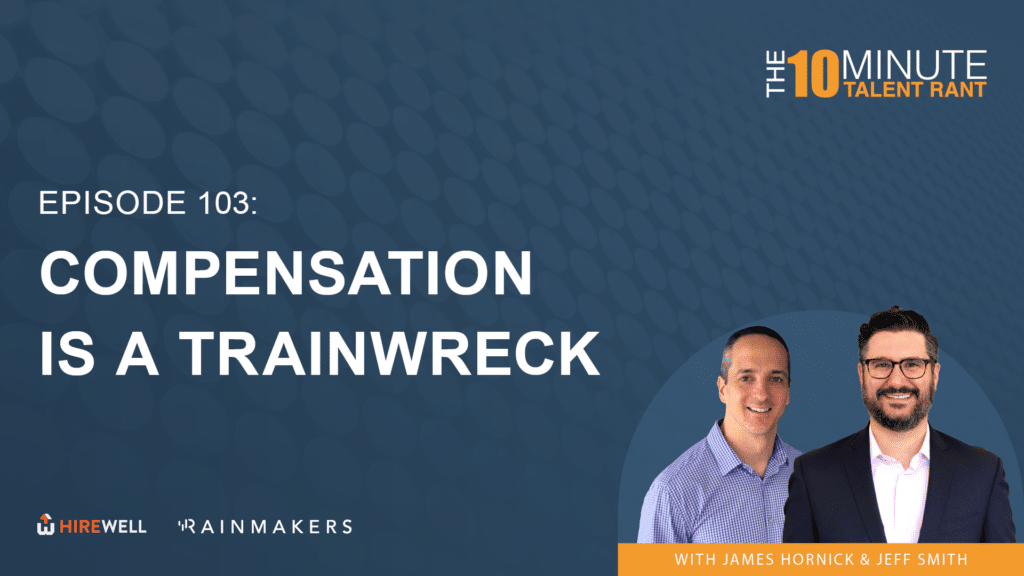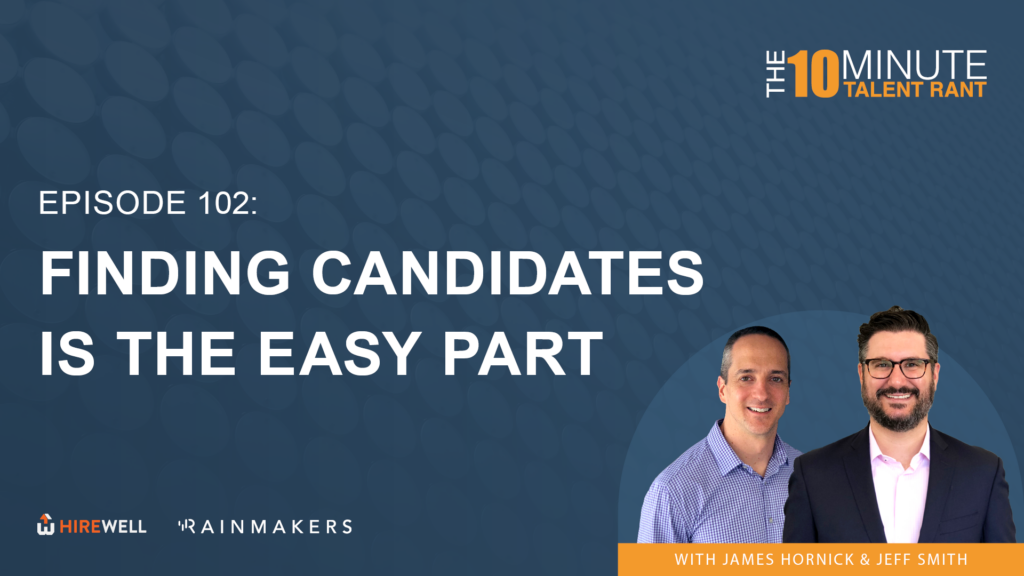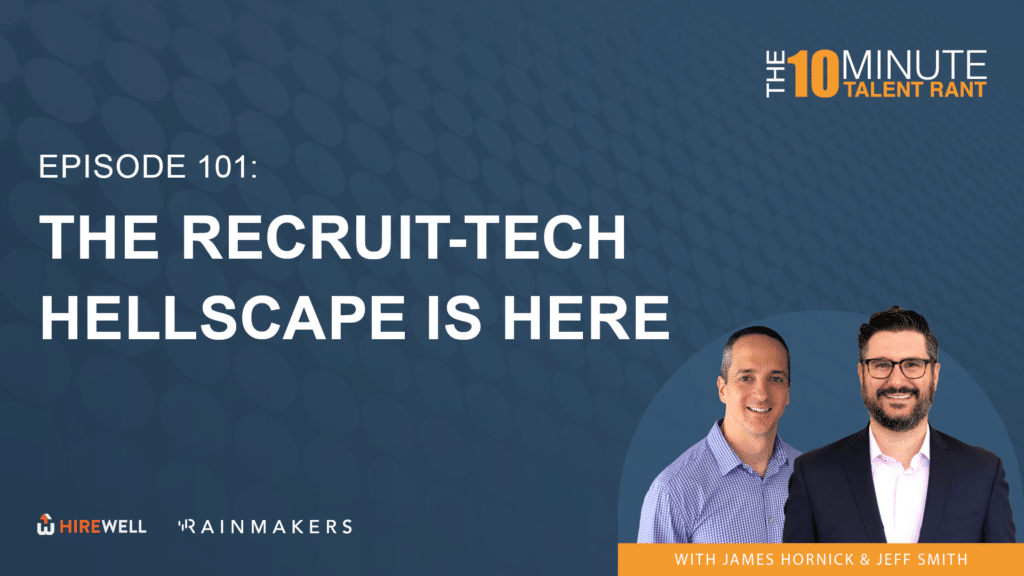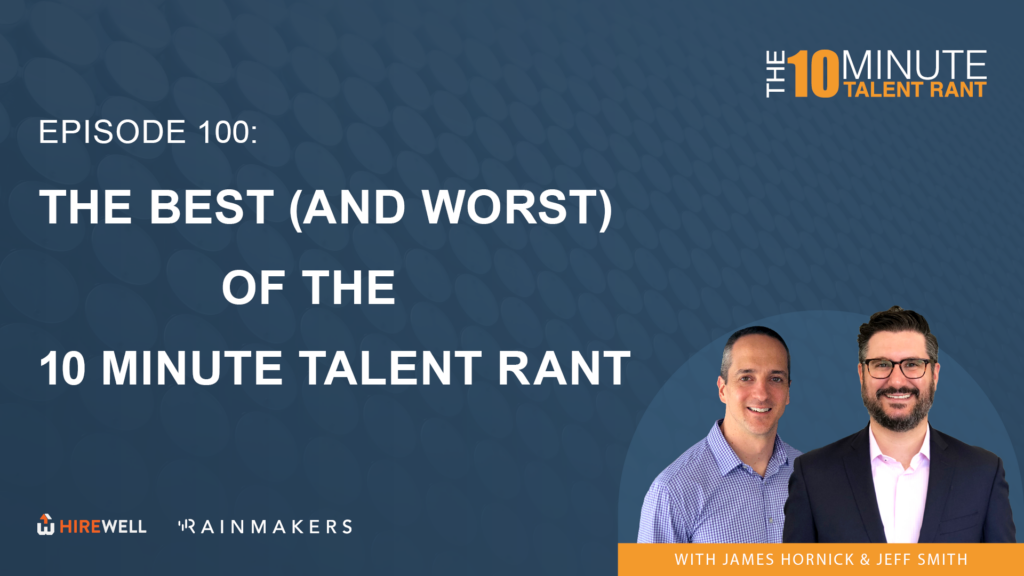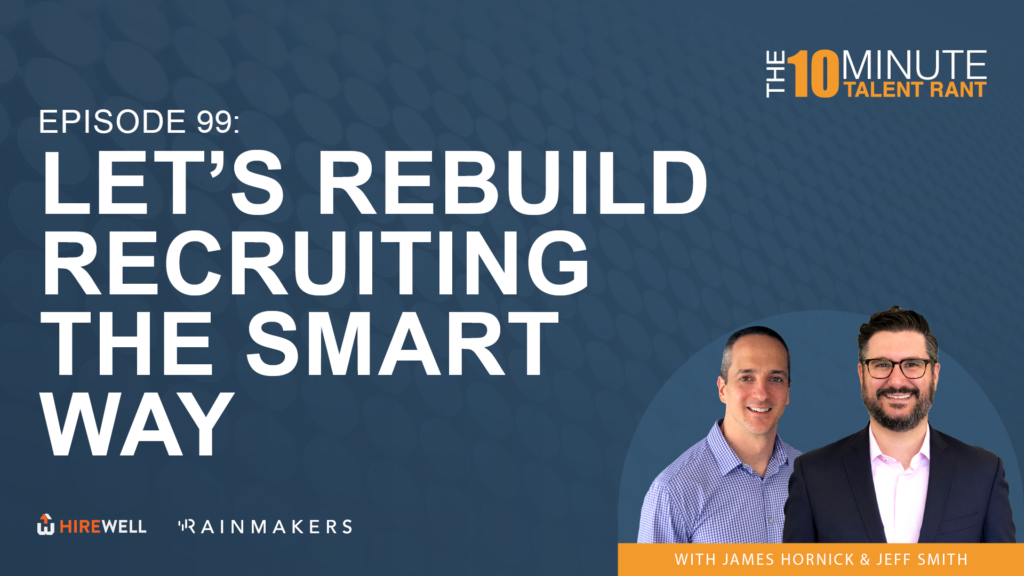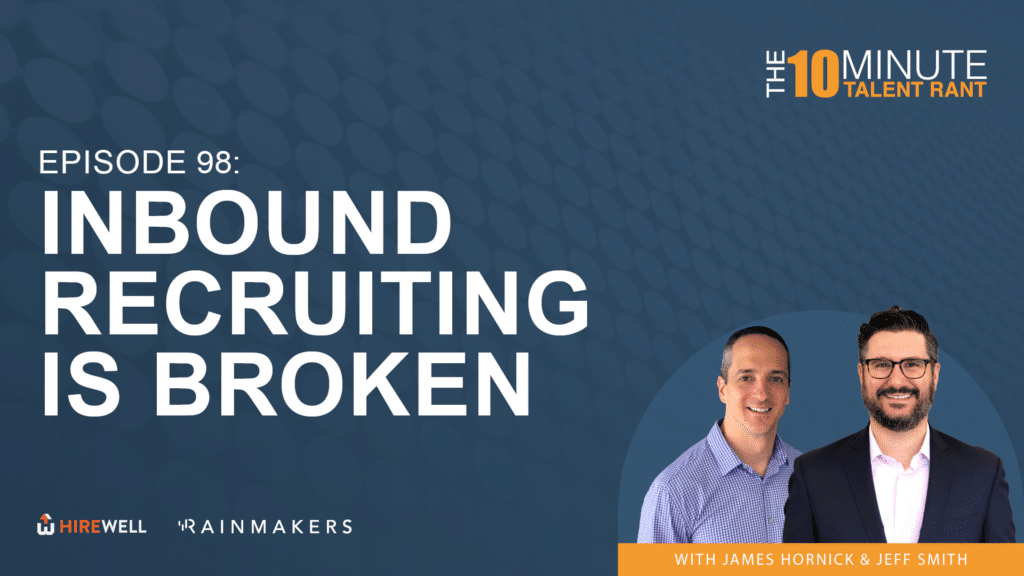The 10 Minute Talent Rant is live! I’m James Hornick, joined by Jeff Smith, and we are on the clock. The 10 Minute Talent Rant is our ongoing series. Where we break down things that are broken in the talent acquisition hiring space, maybe even pitch a solution or two. Before we dig in, all of our content can be found on talentinsights.hirewell.com. This week’s topic, Jeff, episode 88. We’re really getting up there. Neglected markets are dying to hire. They are and we’ll preface this by saying we’ve swum deeply into allocation of minutes. So hopefully this one doesn’t go into like the 17 minute talent rant. Yeah, we hit 20 last week, which is excessive. We have an outside shot of actually keeping this one to 10. Yeah. Okay, so neglected markets. I like that. I also like the term underserved markets. Before the pandemic started, let’s just back up for a minute. We had this big idea. Let’s go after some underserved markets. At the time we were thinking geography specifically, but it kind of goes far beyond that. Which we’ll talk about in a few minutes here. But in those days, kind of pre-pandemic, like I said, we started picking up a few clients in smaller cities, second tier cities. I don’t know if that’s a derogatory term, but Buffalo and Cincinnati and a few places like that, where we actually got really good feedback from our clients.
And if we’re being honest, I think half of it was us doing the job well, but the other half was really like, some of these like smaller markets, there aren’t any good recruiting firms. Like there’s a million recruiting firms in Chicago. There’s a billion in New York and San Francisco, but like a lot of these smaller cities, there aren’t just great organizations to partner with.
And this is back when things were much more kind of regional. Our big box competitors are coastal, which we’ll also get to. Yeah. Then the pandemic hits, we realized personally it was a big opportunity to scale because, by the same logic, there was a lot of good individual recruiters all over the country where just, there just weren’t a lot of great firms to work for.
So that worked out for us. We doubled in size, got a lot of great talent. But it also, getting to the point of the show, it gave us a lot of local presence in a lot more areas nowadays. Yeah, for sure. And like, side note, we think about in office work. in timeline. It hasn’t been around all that long. The sales role, it’s the OG remote job. Remote first job. You had your vacuum cleaner salesman, your knife salesman, you know, the door to door folks, one person offices, like the idea of maintaining, you know, these relationships with customers from some central office is, like, it’s a very recent invention.
Yeah. It’s kind of always boggled my mind a little bit because like salespeople were the original remote workers because they could have better relationships. Anyways, fast forwarding a bit here. Now I have friends, believe this or not, I do have friends. Many of which are outside the LinkedIn bubble.
I don’t believe it. People who work in things like accounting and manufacturing and law and whatnot. And when I would talk about 2023 in those, in that year, about hiring being depressed, they were all like, what the fuck are you even talking about? Like their companies didn’t do layoffs. They were still hiring the entire time through.
They weren’t seeing what we were seeing. All the negative news daily and like the tense tech centric LinkedIn bubble. This all goes part and parcel with everyone having very different, unique experiences during this time. Hiring was down in 2023, but a big part of that was and the big part of the reason so many companies struggle, like, not just in our sector, but marketing firm, software firms, et cetera, is because we office dorks had shiny object syndrome.
So many people in the business world were obsessed with tech firms and Silicon Valley and the cachet that came with other large markets and they ignored the opportunity that existed everywhere else. So, to preface this, we’re going to bucket this into two different things.
There’s two types of underserved markets. What’s the first one? Geographic. So, one thing kind of building up what we’re saying before, what’s been interesting about this year is that we get as many jobs outside of major markets than we do inside them. Like we’ve been a national firm for years now, but historically, we get the most business in Chicago.
It’s because where it’s our hometown, where we have the most staff, it’s where we built, where we came from. Then followed by other big markets, like everyone else, we go after San Francisco, New York, big business on the coast and whatnot. Yeah.
We’ve done business in 20 states so far this year. I don’t know if that’s a record or not, but it’s a lot for us, to put it mildly.
We’ve kicked off new engagements with companies in a lot of the Rust Belt cities, you mentioned Cincinnati, Detroit, Columbus, arguably even smaller markets like Wilkes-Barre, Pennsylvania, Peoria, Meridian, York and Harrisburg, Pennsylvania. These are very, very industrial centric markets. Pointed the pandemic sent actual working humans to more affordable locations and a vast majority of those folks newsflash like their lifestyle and they’re not moving anywhere.
They’re not going to leave. So, in contrast, like we said before, our competitors seem to be running back to what they know. The idea of getting everyone back into the office and subsequently focusing on the larger markets, New York, San Francisco, Atlanta, Chicago, the super hubs, right? It’s left a lot of opportunity on the table for the 20 or so mid market cities that have grown since the pandemic started.
I don’t know why it’s happening, but we’re more than happy to continue to grow in those markets. You know, so that we don’t have to share inside the coast. Yeah, and it’s not and I want to make this clear to it’s not just recruiting. We’re not just talking about our business, but I talked a lot of marketing agency leaders. They’re seeing the same trends, refocusing their own kind of sales efforts and whatnot, because they’re seeing the same types of opportunity like someday interest rates will fall someday. VC money will come back in. It’ll start driving hiring again. But there’s other great organizations out there and other locations to work for that don’t rely on it.
Like they’ve always been there the entire time. They just, they’ve been neglected and they’re happy to finally get some love nowadays. Yeah, you’re also building your services around the same affordable locations and not New York, San Francisco. That’s for another day. The second, one is industry and skills.
You covered geography. We’re going to now talk about industry. We have this was surprising and then not surprising. We have more non-tech clients than we have tech clients, probably for the 1st time in our history. It’s not how we expected to grow, but it’s also a Testament. I think you and I agree of our ability to kind of pivot enough and survive.
So manufacturing, legal, big one, real estate, CPG, healthcare, cannabis. These are a few areas where our business has picked up considerably. And it’s not to say that we’re not seeing business in tech orgs. It’s still per sector, our biggest piece of business. But the growth has occurred from all of those places I just mentioned.
We mentioned last week in our episode that hiring is the goal, not recruiting, and what we’re seeing from these markets is a willingness to forgo these traditionally niche, you know, providers and go a little bit more broad based for the first time, and it’s producing results. So our ability to go to market at that moment in time has paid off.
And the success of that has been a big fresh air for clients, like in the legal industry. We couldn’t have predicted a year ago that we’d have a version in legal practice. And yet here we are. And I think that grit coincides with some of these smaller markets and gives us a competitive edge in places like industrial recruiting, which we know.
Yeah. Fastest area of growth for us is our industrial practice. Now, what that means manufacturing supply chain engineering. These are the skill sets specifically. It’s not just the company, but the types of skills and whatnot. Because I always have to like, talk about like, certain industries that work and then also certain skill sets.
Yeah. It’s not surprising based on the industry growth. But to the point, it’s another market that’s traditionally underserved by recruiting orgs and other types of service providers, not even in recruiting. We just don’t see as much competition in the space because there aren’t that many firms that do it.
And I mean, there’s a million tech recruiting firms out there. It’s by far the most saturated space in recruiting. Tons of sales, recruiting firms, tons of finance and accounting recruiting firms. But there there’s a hell of a lot less places that know how to recruit plant managers and electrical engineers and materials engineers and supply chain operations and things like that.
So good for us, obviously, but just throwing that out there, it’s just another area that’s been neglected. And like, our business is a testament to the fact we’re able to kind of get right into it and do well, so. No doubt. So just a couple of takeaways, you know, nothing earth shattering, but all this said, there’s still challenges.
I mean, the growth number one, the growth of these metro areas, as we mentioned, is built off of remote first flexibility. Most, if not all, of the folks want to continue that remote lifestyle. It’s what brought them there in the first place. So if you want to get workers back into an office space, even in a hybrid setting, the question is, does that negate the entire exercise?
It’s an open ended takeaway. Number two, you begin to establish an actual office presence in these markets, are you limiting your access to the best talents? Again, a simple, but open ended question. If you want some hybrid and onsite interaction, like fine, but is it something that like, my point is you have to constantly analyze and discuss if your company needs to build around these smaller hubs of talent or you go a different path, right?
Yeah. And the last thing I wanted to throw on here kind of as a takeaway too, is like all the same thing applies to job seekers. And there’s a lot of people out there that are still looking for work. There’s a lot more opportunity right now doing the same skill jobs, software engineer, marketer, if you’re in sales, in manufacturing firms and supply chain firms and places like that.
Don’t just look at tech companies because that’s what’s cool and what’s hip and whatnot. There’s just so much more going on in more traditional industries that still need people like you. Anyways. All this is why remote first still makes the most sense in recruiting. If you’re a recruiting firm, like we are able to service more clients because we have more people local and more locations than had we all been in the office all the time.
And I think that’s the difference between services firms and what some of these other industries do. But I did want to kind of point out that when everyone’s talking about what kind of return to work, you know, asking everyone to be in an office can actually make you less accessible to your clients.
If you work outside of one market, which we’re saying you probably should. Yeah. I mean, finally, you can mine candidates from anywhere. The last few years have taught us that you do actually need a local presence, but by local presence, it doesn’t mean an office. It means a handful of folks to be familiar with the community dynamics, et cetera, and run and maintain client relationships at the grassroots level that will continue to be crucial. Yeah, agreed. We are short on clock. We only went over by two minutes. I really thought we’re going to hit 10 this time. Thanks for tuning in to the 10 Minute Talent Rant, part of the Talent Insights series, which is always available for replay on taleninsights.hirewell.com as well as YouTube, Apple Podcasts, Google Podcasts, Spotify, and Amazon. Jeff, thanks again, as always, everyone out there, we will see you soon.







